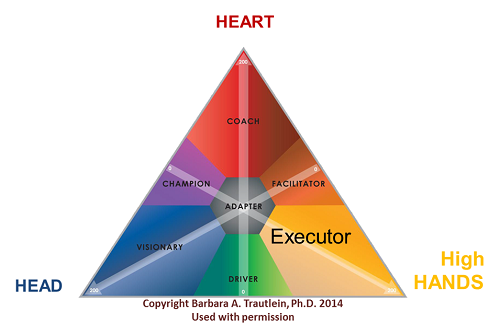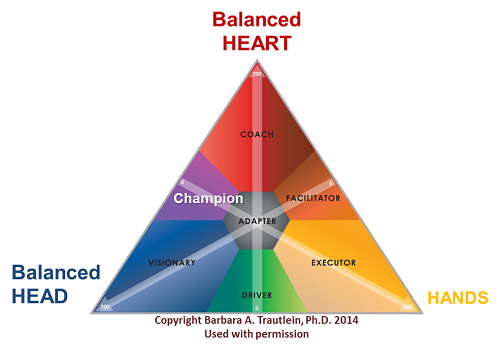When you walk in the room, who shows up for Read more →
Change Intelligence: Executors and Champions
Posted Wednesday, December 17, 2014Change intelligence highlights the need to focus on hands, heart and head for successful change. In today’s post, we will start with the hands – task leadership in change. (By the end, we will cover the heart and head as well.)
Change needs action-oriented leaders. Someone has to plan the work, watch the budget and manage the schedule to keep a change project on target. In other words, change needs executors.
Change Leader: The Executor
Executors are high hands, focusing on task leadership.
 Barbara Trautlein describes executors as systematic planners who are dependable, proficient and efficient. Executors plan the work and then work the plan. They focus on what is doable and they pride themselves on staying on time and on task.
Barbara Trautlein describes executors as systematic planners who are dependable, proficient and efficient. Executors plan the work and then work the plan. They focus on what is doable and they pride themselves on staying on time and on task.
The executor is master of the details. If specifications change, they work out all the implications. If there’s a delay, they know the task interdependencies and the impact on delivery dates. If an unexpected cost is incurred, they dig into the budget and the contract to tack down what happened.
Executors have blind spots, of course. They can be shortsighted, losing site of the vision for the change. Executors can also be narrow, data-bound perfectionists. They can bulldoze people to stay on time, on task and under budget. Because of these blindspots, executors might need help with the heart and head aspects of change leadership.
Leader: The Champion
Across the CQ triangle from the executor, we find the champion, a change leader who is balanced on heart and head.
Trautleins’s motto for champions is “Together We Can Make It Happen!” Champions are compelling and charismatic. They are often powerful and effective communicators. They are audience centered and they stay on message. They create insight and get buy-in from people for the change. Champions are true cheerleaders for change.
Champions also have blind spots. Champions can get bored by the details. They can be overly optimistic and impractical – all cheerleader when a little pragmatism is needed. And, champions are attracted to the flavor of the month. They often move on to the next trend without finishing strong.
The champion’s ability to keeping people motivated toward the bright new future helps balance out the executor’s weaknesses. And, the champion’s weakness on details and lack of a strong finish are compensated by the executor’s focus on planning and execution. These tradeoffs make the executor and the champion a dynamic duo of change leadership.
What if the executor can’t pair up with a champion? An executor can look for two or more partners in change.
You want at least one visionary or driver to provide thought leadership. Then, the executor’s work plan will be linked to the vision for change.
You also want at least one coach or facilitator to provide relational leadership to ensure people are cared for in the midst of change.
Bottom line: Your change leaders can be a dynamic duo of executor and champion, or they can be a bigger team. The key is to have leaders who focus on hands, head and heart – work plans, vision and engagement – to make change happen. Anything less is a plan for failure.




Pingback: Change Intelligence: Executors and Champions | ...
Pingback: The Platinum Rule for Visionary Change Leaders
Pingback: The Platinum Rule for "Just Do It" Change Leaders
Pingback: The Platinum Rule for People-Focused Change Leaders